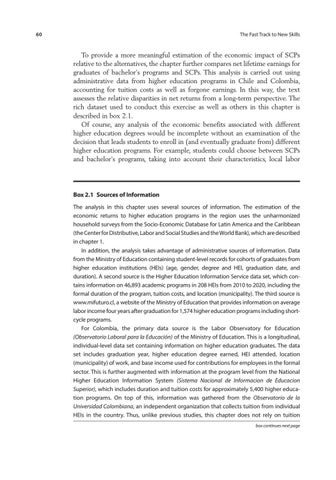60
The Fast Track to New Skills
To provide a more meaningful estimation of the economic impact of SCPs relative to the alternatives, the chapter further compares net lifetime earnings for graduates of bachelor’s programs and SCPs. This analysis is carried out using administrative data from higher education programs in Chile and Colombia, accounting for tuition costs as well as forgone earnings. In this way, the text assesses the relative disparities in net returns from a long-term perspective. The rich dataset used to conduct this exercise as well as others in this chapter is described in box 2.1. Of course, any analysis of the economic benefits associated with different higher education degrees would be incomplete without an examination of the decision that leads students to enroll in (and eventually graduate from) different higher education programs. For example, students could choose between SCPs and bachelor’s programs, taking into account their characteristics, local labor
Box 2.1 Sources of Information The analysis in this chapter uses several sources of information. The estimation of the economic returns to higher education programs in the region uses the unharmonized household surveys from the Socio-Economic Database for Latin America and the Caribbean (the Center for Distributive, Labor and Social Studies and the World Bank), which are described in chapter 1. In addition, the analysis takes advantage of administrative sources of information. Data from the Ministry of Education containing student-level records for cohorts of graduates from higher education institutions (HEIs) (age, gender, degree and HEI, graduation date, and duration). A second source is the Higher Education Information Service data set, which contains information on 46,893 academic programs in 208 HEIs from 2010 to 2020, including the formal duration of the program, tuition costs, and location (municipality). The third source is www.mifuturo.cl, a website of the Ministry of Education that provides information on average labor income four years after graduation for 1,574 higher education programs including shortcycle programs. For Colombia, the primary data source is the Labor Observatory for Education (Observatorio Laboral para la Educación) of the Ministry of Education. This is a longitudinal, individual-level data set containing information on higher education graduates. The data set includes graduation year, higher education degree earned, HEI attended, location (municipality) of work, and base income used for contributions for employees in the formal sector. This is further augmented with information at the program level from the National Higher Education Information System (Sistema Nacional de Informacion de Educacion Superior), which includes duration and tuition costs for approximately 5,400 higher education programs. On top of this, information was gathered from the Observatorio de la Universidad Colombiana, an independent organization that collects tuition from individual HEIs in the country. Thus, unlike previous studies, this chapter does not rely on tuition box continues next page

